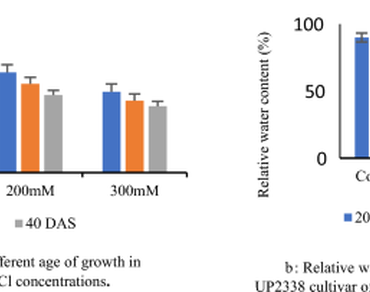Investigating biochemical changes and protein profile of salt-tolerant and salt-sensitive wheat cultivars in response to salinity stress
Short Communications | Published: 19 August, 2024
First Page: 2154
Last Page: 2161
Views: 2298
Keywords: Wheat, Protein Profile, Osmoprotectant
Abstract
In a pot experiment, biochemical response of two wheat cultivars, KRL 1–4 and UP 2338 (Triticum aestivum L.), was assessed under varying salinity levels. Salinity was applied at three concentrations (100, 200, and 300 mM NaCl), and untreated plants served as controls. Samples were collected at 20, 30, and 40 days after sowing (DAS) to evaluate proline content, total reducing sugar content, total nitrogen content, and total protein content. SDS-PAGE was used for protein profiling. Results demonstrated that proline and reducing sugars increased with higher salinity, particularly in the tolerant KRL 1–4 cultivar. Conversely, total nitrogen and protein content decreased with rising salt concentrations, and sensitive UP 2338 cultivar exhibited more pronounced reductions. The impact of salinity on protein synthesis was investigated, revealing a new 17 kDa protein exclusively present in tolerant cultivar. Another new protein of approximately 87 kDa was observed in 100 mM NaCl-treated sample of sensitive cultivar. 23 kDa protein increased in 200 and 300 mM NaCl-treated sensitive cultivar, while it remained constant in the treated tolerant samples. Proteins within 20–30 kDa range were more abundant in tolerant cultivar, while both cultivars showed decreased levels of proteins at 68, 66, 44, and 38 kDa, with sensitive cultivar experiencing more significant reductions. These findings provide insights into biochemical responses of wheat cultivars to salinity stress and identify potential protein markers associated with salt tolerance.

References
Augé RM, Toler HD, Saxton AM (2014) Arbuscular mycorrhizal symbiosis and osmotic adjustment in response to NaCl stress: a meta-analysis. Front Plant Sci 5:562. https://doi.org/10.3389/fpls.2014.00562
Bates LS, Waldren RP, Teare ID (1973) Rapid determination of free proline for water-stress studies. Plant Soil 39(1):205–207
Bradford MM (1976) A rapid and sensitive method for the quantitation of microgram quantities of protein utilizing the principle of protein-dye binding. Anal Biochem 72(1–2):248–254
Doneen LD (1932) A rapid method for determination of total nitrogen in soils. Proc Am Soc Agron 25(1):558–560
FAO. (2015). Global Soil Salinity Map -Version 1.1. Food and Agriculture Organization of the United Nations. Retrieved from http://www.fao.org/soils-portal/soil-salinity-and-sodicity/global-maps/en/
Giraldo P, Royo C, Gonzalez MA (2019) Grain number determination in bread wheat (Triticum aestivum L.). J Exp Bot 70(5):1421–1430
Iqbal MN, Ashraf M, Hussain M, Jamil A (2019) Plant growth, yield, and ionic relations of salt-stressed wheat as affected by seed priming with ascorbic acid. J Agron Crop Sci 205(1):9–19. https://doi.org/10.1111/jac.12292
Laemmli UK (1970) Cleavage of structural proteins during the assembly of the head of bacteriophage T4. Nature 227(5259):680–685
Li J, Wang Y, Zhang J (2017) Proteomic analysis of salt tolerance in wheat germplasm by two-dimensional electrophoresis. Int J Mol Sci 18(5):980. https://doi.org/10.3390/ijms18050980
Liang M, Wu Y, Zhang H (2017) Transgenic arabidopsis thaliana overexpressing a WD40 repeat gene from triticum urartu enhances salinity tolerance. PLoS ONE 12(5):e0177088. https://doi.org/10.1371/journal.pone.0177088
Munns R, Tester M (2008) Mechanisms of salinity tolerance. Annu Rev Plant Biol 59:651–681. https://doi.org/10.1146/annurev.arplant.59.032607.092911
Nassar RMA, Abdelhamid MT, Ashoub A (2020) Salinity stress impact on wheat’s physiological traits during grain filling stage. Plants 9(1):70. https://doi.org/10.3390/plants9010070
Sabagh AE, Kordrostami M, Soltani A (2021) Assessment of the impact of salinity stress on wheat growth and development. Plant Stress Physiol 9(2):1–10. https://doi.org/10.37159/psp/9.2.1
Singh D (2022) Juggling with reactive oxygen species and antioxidant defense system: a coping mechanism under salt stress. Plant Stress. https://doi.org/10.1016/j.stress.2022.100093.UN
Somogyi M (1952) Notes on sugar determination. J Biol Chem 195(1):19–23
The State of Food Security and Nutrition in the World 2018. Food and Agriculture Organization of the United Nations. Retrieved from http://www.fao.org/state-of-food-security-nutrition/en/
Weatherly PE (1965) Studies in the water relations of the cotton plant I. The field measurement of water deficits in leaves. New Phytol 64(1):81–97
Author Information
Biological Science Department, Rani Durgavati University, Jabalpur, India